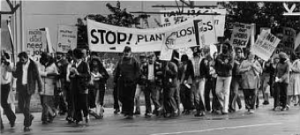In these times of job scarcity, a job seeker in California can do everything right and still be unable to find a job. So too, a local Workforce Investment Board (WIB) can do everything right in a job placement or replacement program, and not be able to place participants. These truths come through in two fine articles on job placement that have appeared in recent days.
The first of these two articles, “A brutal Labor Day for some ex-Nummi workers”, by San Francisco Chronicle business columnist Andrew S. Ross, profiled former workers at the NUMMI plant in Fremont. The NUMMI plant closed in March 2011, laying off 4700 workers. Ross found that within 2 years less than half of the NUMMI workers reported being in a new job. Tesla had taken over the NUMMI plant, but its hiring of former NUMMI workers amounted to fewer than 50 by the end of 2012.
 There was no dearth of job training funds. The federal government quickly provided $19 million in dislocated worker training funds.
There was no dearth of job training funds. The federal government quickly provided $19 million in dislocated worker training funds.
Further, the Alameda County WIB followed all of the best practices in developing a retraining program. It created the NUMMI Reemployment Center near the plant, and developed individual employment plans for each worker, tailored to the skills and interests of each worker. It underwrote training in fields such as medical technician, dental technician, welder and trucker, but only to the extent that job prospects appeared promising. It brought on job placement specialists, and established metrics of placement.
Ross used the job search of one worker, Ms. Deborah Arroyo, to illustrate the difficulties of retraining and replacement. Ms. Arroyo had worked at the NUMMI plant for 18 years, and by 2011 was earning $30 an hour, with health insurance. After NUMMI closed, she undertook and completed a training course to be a medical technician, but was unable to find a job. She next tried volunteering, doing a six month unpaid internship at a doctor’s office. But that too did not lead to a job. Today, she continues to volunteer at Washington Hospital in Fremont.
It’s difficult to see anything she did or that the WIB did that was not the right approach for retraining. She trained in an occupation that is in demand and growing in number. She found a way to “get in the door” by volunteering. She was assisted in her job search by Reemployment Center staff. Her age, 61, made the search more difficult, but what could she do about her age–other than to be as vigorous as positive.
The effective retraining programs in California today tailor job training to the local labor market, utilize a variety of job placement techniques, and find ways for retraining participants to get in the door. The Alameda County WIB followed all of these strategies.
The second Labor Day article appeared in the San Jose Mercury News, “Many older workers are still struggling despite the ‘recovery’ around them”, by Patrick May. It detailed the difficulties of workers in Silicon Valley over 40 years of age, and especially over 50 years of age. Again, most of these workers are doing everything right in their job searches. They are following the best practices in resume writing. They are using individual networks and online networks. They are taking part time work or any gigs to get in the door, including volunteering.
Those who are finding jobs often are doing so in the booming Silicon Valley at well below their former salaries. 54-year old Howard Greenstein tells May, “I feel like I’ve lost 10 years of my life”. After 6-7 years of part time and irregular employment, he found a program manager position 3 years ago, earning the same salary as in 1995. According to May, two-thirds of workers between 55-64 who found work after losing it in the Great Recession are making less, and the average time to find a job for this group has been 46 weeks.
A 59-year old Sunnyvale resident with a Wharton School MBA is working as an executive assistant earning 30% less than she did prior to the Great Recession. She tells May, “I feel blessed to have a job, especially knowing that many others are still out there struggling to find something.”
 As job seekers, job coaches and as workforce practitioners, we want to do everything possible and everything right in job search—at the same time acknowledging that even these actions often may not be enough in these days.
As job seekers, job coaches and as workforce practitioners, we want to do everything possible and everything right in job search—at the same time acknowledging that even these actions often may not be enough in these days.

